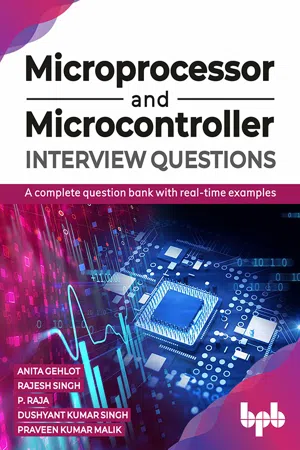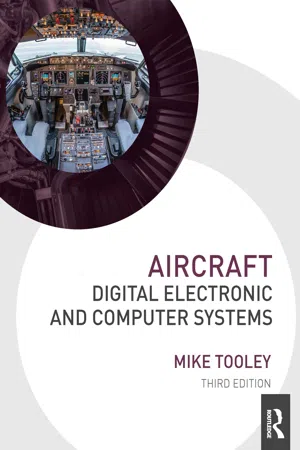Computer Science
Fetch Decode Execute Cycle
The Fetch-Decode-Execute cycle is the process by which a computer retrieves a program instruction from memory, decodes it, and then executes it. This cycle is repeated continuously, allowing the computer to carry out a series of instructions in order to perform a task.
Written by Perlego with AI-assistance
Related key terms
Related key terms
1 of 4
Related key terms
1 of 3
4 Key excerpts on "Fetch Decode Execute Cycle"
- eBook - ePub
Microprocessor and Microcontroller Interview Questions:: A complete question bank with real-time examples
A complete question bank with real-time examples
- Anita Gehlot(Author)
- 2020(Publication Date)
- BPB Publications(Publisher)
Answer: The processor cycle or machine cycle is the basic external operation performed by the processor. To execute an instruction, the processor will run one or more machine cycles in an order.48. What is instruction cycle?Answer: The sequence of operation that a processor must carry out while executing an instruction is called instruction cycle. Each instruction cycle of a processor in turn consist of several machine cycles.49. What is fetch and execute cycle?Answer: The instruction cycle is consisting of fetch cycle and execution cycle. During fetch cycle processor reads the opcode from the memory and during execute cycle processor executes the instruction which is in decoded form from the instruction decoder.50. List the various machine cycles of 8085. Answer: The various machine cycles of 8085 are:- Opcode fetch cycle
- Memory read cycle
- Memory write cycle
- I/O read cycle
- I/O write cycle
- Interrupt acknowledge cycle
- Bus idle cycle
Answer: T-state: One sub-division of an operation performed in one clock cycle is called a T-state.52. Define opcode and operand.Answer: An opcode is a single instruction that can be executed by the CPU. In machine language, it is a binary or hexadecimal value such as ‘B6 ’ loaded into the instruction register.In assembly language mnemonic form an opcode is a command such as MOV or ADD or JMP. For example MVI A, 34HThe opcode is the MVI instruction. The other parts are called the ‘operands ’.Operands are manipulated by the opcode. In this example, the operands are the register named A and the value 34 hex.53. How the 8085 processor differentiate memory access (read/write) and IO access (read/write)?Answer: In 8085 processor memory access and I/O access is differentiate by the help of IO/ . When IO/ = 0, then Processor will access or do the memory operation whereas IO/ - eBook - ePub
- Mike Tooley(Author)
- 2022(Publication Date)
- Routledge(Publisher)
Figure 7.6 ).Figure 7.6 (a) Read and (b) write operationsEach cycle of CPU operation is known as a machine cycle. Program instructions may require several machine cycles (typically between two and five). The first machine cycle in any cycle consists of an instruction fetch (the instruction code is read from the memory) and is known as the M1 cycle. Subsequent cycles M2, M3 and so on, depend on the type of instruction that is being executed. This fetch–execute sequence is shown in Figure 7.7 .Figure 7.7 A typical timing diagram for a microprocessor CPU’s fetch–execute cycleMicroprocessors determine the source of data (when it is being read) and the destination of data (when it is being written) by placing a unique address on the address bus. The address at which the data is to be placed (during a write operation) or from which it is to be fetched (during a read operation) can either constitute part of the memory of the system (in which case it may be within ROM or RAM) or it can be considered to be associated with input/output.Since the data bus is connected to a number of VLSI devices, an essential requirement of such chips (e.g. ROM or RAM) is that their data outputs should be capable of being isolated from the bus whenever necessary. These chips are fitted with select or enable inputs that are driven by address-decoding logic that ensures that external devices (ROM, RAM and I/O) never simultaneously attempt to place data on the bus.The inputs of the address-decoding logic are derived from one or more of the address bus lines. The address decoder effectively divides the available memory into blocks corresponding to a particular function (ROM, RAM, I/O, etc.). Hence, where the processor is reading and writing to RAM, for example, the address-decoding logic will ensure that only the RAM is selected while the ROM and I/O remain isolated from the data bus. - eBook - ePub
Information Technology
An Introduction for Today's Digital World
- Richard Fox(Author)
- 2020(Publication Date)
- Chapman and Hall/CRC(Publisher)
own hardware. Fetching requires the PC and the L1 instruction cache where the PC is incremented before the end of the current cycle. Decoding uses the IR. Fetching operands uses the register file. Executing the instruction requires the ALU and if the instruction is a data movement operation (load or store from memory), the L1 data cache. Storing the result uses the register file. Two stages use the register file but accessing registers is the fastest part of this cycle, so we can accommodate all register accesses in one clock cycle.A pipeline of our five-stage fetch-execute cycle is shown in Figure 2.15 . The fetch stage uses the PC and instruction cache, with the PC being incremented after the instruction is fetched. The instruction, upon being fetched, moves into the IR, which is part of the decode stage. The control unit decodes the instruction in the IR to identify the operation and identify operand location. The operation is sent to the execute stage 2 cycles later to select the ALU circuit (for ALU operation) or data cache (for load or store operation) while the operand address information is used one and three stages later when selecting registers. In stage 3, any operands needed for the instruction are fetched from the register file. These values, along with the instruction from the decode stage, are moved into the execute stage. The execute stage, stage 4, receives the data and executes the instruction on that data. There are three general forms of execution: ALU operations, branches, and loads/stores. The figure shows the ALU. Branches modify the PC (not shown in the figure), so the PC could be changed both during the instruction fetch stage and the execute stage. Loads/stores use a separate data cache (not shown). In stage 5, any result from the ALU or loaded from the data cache is moved back into the register file.The key to understanding Figure 2.15 - Ed Lipiansky(Author)
- 2012(Publication Date)
- Wiley-IEEE Press(Publisher)
(1) instruction fetch, (2) instruction decode (3) instruction execution . From a digital design standpoint each of the stages mentioned may be have one or more states.10.4.1 Data Path: LDA Instruction Fetch, Decode and Execution RTL
When an instruction has to be fetched from memory the Program Counter Register (PC), which should have the address of the to-be-executed instruction has to transfer its contents to the MAR . To fetch an instruction means that the instruction has to be read from memory and be placed in some register within the CPU. Remember that our CPU instructions are only one 16 -bit word long and it is not a multi-word instruction like in some advanced machines. The instruction upper four bits are the opcode and the lower 12 bits are address X . Refer to the ISW in Table 10.1 . Upon being fetched, the instruction needs to be decoded; this tells the CPU what instruction was just fetched from memory and what else it needs to do. Upon the CPU figuring out which instruction it fetched, and assuming that in our example it was a LDA A, (X) ; the CPU knows that it requires bringing a word of data from a memory location whose address is X . Such data are copied from memory into the memory MBR . Lastly the CPU transfers such word, now in the MBR , to accumulator register A . This last data path transfer finalizes the execution phase of the instruction. That is, A ← (X ), refer to Table 10.2 .Let us look at the data path architecture diagram of Figure 10.6 . Our complete simple CPU data path and its main memory interface consist of four registers and the ALU. The PC register holds the address of the to-be executed instruction for the currently being executed instruction. The MAR register holds the address of a memory location the CPU wants to access. The MBR register is used to read data from and write data to memory. Remember that the PC register shown in Figure 10.6 is actually all the logic of Figure 10.5 . We will explain the need for the MAR and the MBR multiplexers in the data path as we explain the operation of key instructions that use such muxes. Going back one more time to our LDA
Index pages curate the most relevant extracts from our library of academic textbooks. They’ve been created using an in-house natural language model (NLM), each adding context and meaning to key research topics.
Explore more topic indexes
Explore more topic indexes
1 of 6
Explore more topic indexes
1 of 4



